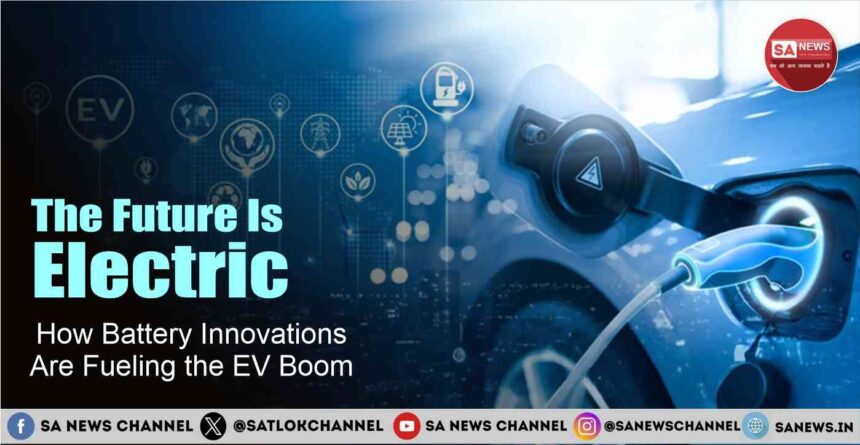Around 14 million EVs were sold in 2023, marking a huge expansion in the industry but do you know the one component that has the power to make or break the future of Electric Vehicles (EVs)? While Electric Vehicles (EVs) may seem like a futuristic breakthrough, they have actually been around for nearly two centuries. So, what changed? Why did electric cars disappear, only to make a roaring comeback?
- EVs Aren’t New — Just Forgotten
- Why Are Electric Vehicles Making a Comeback?
- What’s Driving The EV Revolution?
- What Makes Solid-State Batteries Revolutionary?
- Are Electric Vehicles really the future?
- The Promises of the EV Industry
- The Final Takeaway
- Balancing Progress with Spiritual Wisdom
- EV Battery Tech FAQ
- What is the battery technology for EV?
- Which EV has the best battery tech?
- What battery tech does Tesla use?
- Connect With Us on the Following Social Media Platforms
In this article, we’ll explore the rise, fall, and resurgence of EVs, with a particular focus on the evolution of battery technology since it’s the only key factor that can either make or break the mass EV adoption.
EVs Aren’t New — Just Forgotten
We’ve all been hearing about how Electric Vehicles (EV) are breaking the ground and the future being electric. But apparently, EVs are actually nothing new. They date back to 1832 long before the very first gasoline powered car. It doesn’t just end here – In Fact, the first car to ever go faster than 100km/h was an electric car!
Timeline at a glance:
- 1832: The first crude electric vehicle was developed by Robert Anderson.
- 1899: The first car to exceed 100 km/h, was electric.
- 1910: Electric cars were twice as common as gasoline vehicles in the U.S.
By 1910, people were highly satisfied with their good simple electric vehicles and they were twice as common on the American roads as internal combustion engines. However as time passed, as the winds didn’t ask, the tides didn’t warn, the use of EV cars changed significantly in no time.
The innovations in gasoline vehicles accelerated and finally, Ford’s Model T came into the spotlight which was several times cheaper than the comparable electric cars. They could be quickly refueled, allowing you to travel farther, faster and cheaper than electric cars.
And just like that by 1935, The market of electric vehicles was completely wiped out due to the following reasons:
- Rise of Gasoline Cars: The Ford Model T was much cheaper and could be quickly refueled.
- Limited Battery Technology: EVs had short ranges and long charging times.
- Infrastructure and Cost: Gas stations became widespread, while charging solutions for EVs were nearly nonexistent.
For decades, fuel-powered vehicles have dominated the industry. But now, EVs are making a strong comeback.
Why Are Electric Vehicles Making a Comeback?
The downfall of electric vehicles was due to their limitations with the battery technology available at that time, electric cars were expensive and short-ranged, hence making it completely impractical for everyday use.

Now you may ask – Why are electric vehicles the future? The answer is pretty simple, the industry has turned their weakness into their strength. Advancements in battery technology, which far surpasses the expectations making it a better alternative to fuel-powered vehicles!
Let’s dive deeper and broaden our understanding of batteries since they essentially make all the difference, after all the key factor that will make or break mass EV adoption, is the battery itself.
What’s Driving The EV Revolution?
The innovation in battery technology has given us a big hope that our future is still secure while reducing the dependence on fossil fuels.
Lead-Acid Batteries
The ground-breaking ‘Jamais Contente’ (the first vehicle to cross 100kmph) was powered by lead acid batteries, which were heavy, had low energy density and suffered from long charging times. Because of their limitations, these batteries were replaced by Lithium Ion Batteries:
Limitations:
- Excessive Weight – Their heavy structure reduced vehicle efficiency.
- Low Energy Density – It stored very little energy relative to their size.
- Long Charging Times – Recharging was a slow and inconvenient process.
- Limited Storage Capacity – Reduced range, made them impractical for long distances.
- Poor Efficiency – Significant energy losses during charging and discharging.
- Short Lifespan – Frequent replacements were needed due to degradation over time.
Rise of Lithium Ion Batteries
Batteries have gotten a lot better overtime, especially with the advancements led by lithium-ion. At first, it was used in mobile phones and other consumer products, which eventually brought their manufacturing costs down, driven by demand and supply. These packed almost twice as much energy in the same volume compared to their next-best competitor.
Also Read: Historic Landing of First Passenger Electric Airplane at JFK Airport
Eventually becoming the best go-to choice for the automotive industry, promising a bright future for the EV-market significantly, also better than lead-acid and nickel-metal hydride batteries.
Advantages:
- Higher energy density – almost double that of the next-best battery chemistry.
- Lighter weight – crucial for improving vehicle efficiency and range.
- Faster charging capabilities – reducing downtime for users.
- Longer lifespan – It reduces the long term maintenance cost of the vehicle as the battery life increases exponentially.
But the innovation doesn’t end here. Over the years, continuous improvements were made to increase energy density and reduce costs. It has given a significant rise to the development of Solid State Batteries.
Solid State Batteries – The Hype
They’ve been the subject of hype for a while. You must be wondering, what’s so groundbreaking about them? Lithium-ion batteries which are used in EVs today, have a liquid electrolyte solution between the cathodes and anodes, and Solid State Batteries make use of solid electrolytes.
Now here’s the breakthrough and the interesting part – this means they’ll have a much higher energy density, implying they can hold up multiple times the capacity of a lithium-ion battery in the same size! Moreover, they won’t be needing any monitoring or temperature control like lithium ion batteries do, saving so much space at the same time as well.
This essentially means we’ll have more space in the vehicle chassis while also making it lighter, improving the overall range of the vehicle and having much faster charging times, as per the reports.
Now naturally, you would wonder – ‘If it is so promising then Why aren’t we seeing solid state batteries in vehicles already?’
The answer lies in the manufacturing costs. As an emerging innovation, it’s hard to manufacture them on a large scale, given their manufacturing is more complex than that of lithium-ion batteries.
What Makes Solid-State Batteries Revolutionary?
There are certain aspects which make solid-state batteries entirely unique from other types of batteries.
- Higher energy density — two to three times as compared to Lithium-Ion batteries
- No liquid electrolyte, reducing risks of overheating and fires.
- Lighter weight and more compact design, improving vehicle range.
- Faster charging times.
As of today, solid state batteries are still in development and research. However, solid state batteries aren’t the only breakthrough batteries. We’ll need more than that and the industries are already on it.

VolksWagen Group’s battery company PowerCo and QuantumScape have collaborated into a revolutionary solid state batteries deal in May, 2024 as per the official press release. PowerCo can manufacture upto 40 GWh using Quantumscape’s technology with an option to expand it to 80 GWh, allowing their manufacturing to cater 1 million EVs annually. (Source)
Are Electric Vehicles really the future?
- Imagine a world where cars are quiet, clean, and cost less to run. That’s exactly what electric vehicles (EVs) bring to the table. And what’s even better? You never have to visit a petrol station since you can charge them at your home at your leisure!
- Not only are EVs better for the environment (no dirty fumes coming out of the back), but they’re also easier on your wallet.
- And what’s even better? Electricity is much cheaper than fuel, and because EVs have fewer moving parts, they don’t break down as often.
- Say goodbye to oil changes and expensive engine repairs- convenient and reducing the maintenance costs by a big amount.
With all the proceeding innovations, Electric Vehicles surely show signs of a promising future- a better clean future.

In the future, owning a car might not even be necessary. Instead, self-driving electric vehicles could become a service – just call a ride whenever you need one. There’s so much more to this but let’s keep it for the next time, anyhow it’s clear that the road ahead is electric!
The Promises of the EV Industry
With the growing innovation in batteries, brands are constantly trying their best to keep up to provide the best experiences to customers.
- By 2028, Toyota has planned to enter the EV market by using the solid state battery development technology. They claim their batteries could offer a range of up to 746 miles on a single charge and recharge in just 10 minutes, rivaling the convenience of refueling gasoline vehicles. (Source: Reuters)
- Volkswagen has heavily invested in QuantumScape, a U.S.-based company specialising in solid-state battery technology. Their prototype uses a solid ceramic electrolyte with high dendrite resistance, enabling fast charging and improved safety. (Source: Volkswagen)
- By the late 2020s, Honda (developing solid-state batteries in its Tokyo-based lab) has plans to launch EVs. (Source: Honda)
- The Chinese automaker Nio is actively researching solid-state batteries, emphasising their potential for extended range and improved safety.
- Focusing on higher energy density and longer lifespans, the advancement in the solid-state battery program is making BMW grow in the EV market. They aim to integrate this technology into their EV lineup by the end of the decade. (Source: BMW)
The key factor holding Electric Vehicles (EVs) back in the past was battery technology, but with advancements in lithium-ion and the promising future of solid-state batteries, EVs are becoming more practical, efficient, and powerful than ever before.

Unlike internal combustion engines, which have reached their innovation limits, EVs are just getting started. With lower running costs, minimal maintenance, and an increasing range, EVs are a much greener alternative in a world where it’s much needed!
With governments pushing for net-zero emissions, automakers investing in next-gen batteries, and consumers embracing cleaner alternatives, the shift to EVs is now no longer a question.
The Final Takeaway
The automotive industry is shifting towards electric mobility at an unprecedented pace. The need of humanity is again driving the change but this time it is here to leave an impact.
The arrival of battery based transportation systems describes the importance of pure and efficient alternatives over harmful ones. Moreover, it also highlights our deeper need to attain purity and sustainability, symbolising the reliance on the right source of energy.
Mirroring the situation into our lives, the quest to attain the right source of energy looms over us, directing us towards multiple spiritual paths without questioning their beliefs. Just like the scientists and researchers relied heavily on lithium ion batteries without recognising their limitations, in the same way we are following the traditional religious practices without verifying it through our holy scriptures.
Balancing Progress with Spiritual Wisdom
Just like the scientists have looked for a more sustainable source for the energy, in the same way spiritual seekers should also seek an authentic and evidence-based religious path. And that’s where the path enlightened by Jagatguru Tatvdarshi Sant Rampal Ji Maharaj comes into the picture.
He describes that the only way to attain peace, happiness and salvation is through the worship backed by our sacred scriptures. He even presented a careful analysis from the holy scriptures of all religions to make His points even more clearer.
Understanding His viewpoints about the creation of the universe in the following video, it will help you to realise that the true spiritual knowledge of Sant Rampal Ji Maharaj is a breakthrough. And the method of worship given by Him is a permanent solution to our sufferings.
For a deeper analysis, visit www.jagatgururampalji.org to order a free copy of His book ‘Gyan Ganga’ or you can visit His youtube channel ‘Sant Rampal Ji Maharaj’ to watch His breathtaking spiritual discourses.
EV Battery Tech FAQ
What is the battery technology for EV?
Currently, most of the EVs are running on lithium ion batteries. But, researchers and scientists are planning to use solid state batteries in the future.
Which EV has the best battery tech?
Tesla
What battery tech does Tesla use?
Tesla uses lithium ion batteries, and is working on dry electrode methods.









